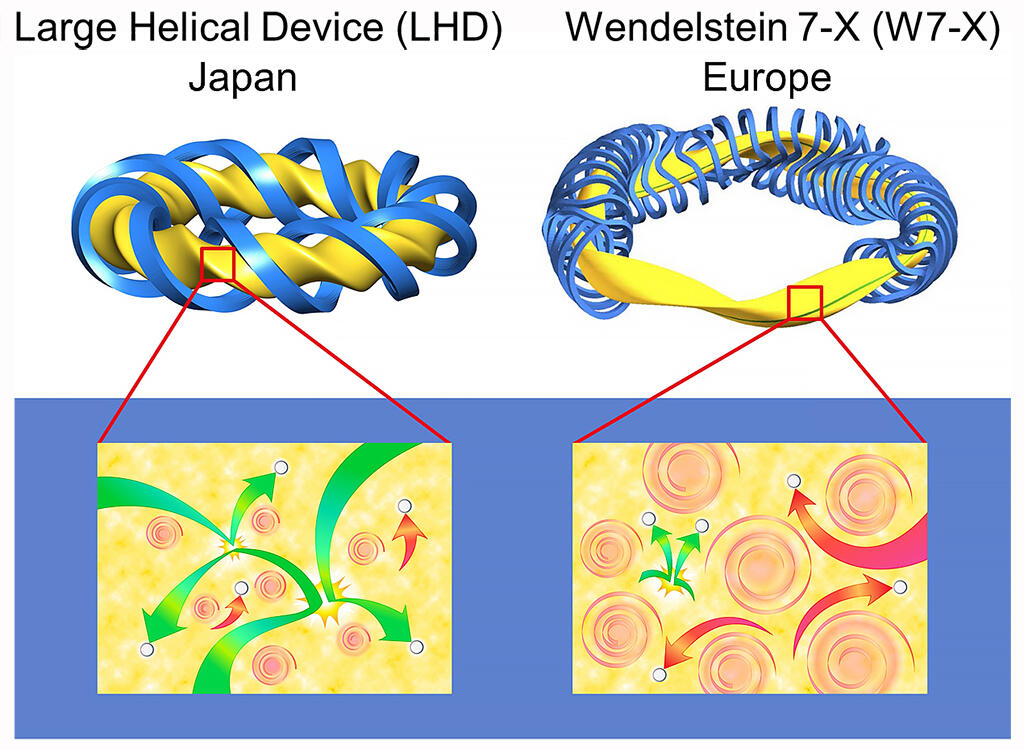An international collaborative research group comprised Professor Kenji Tanaka of the National Institute for Fusion Science, Associate Professor Masanori Nunami, Associate Professor Motoki Nakata, Doctor Felix Warmer of the Max Planck Institute for Plasma Physics (IPP), and Doctor Pavlos Xanthopoulos, and others conducted the world's first detailed comparative experiment between the Large Helical Device (LHD) in Japan and the Wendelstein 7-X device (W7-X) in Germany. The group clarified that the structure of the magnetic field that traps the plasma has an important effect on turbulence suppression. This result shows a new possibility of suppressing turbulence and is expected to greatly contribute to research aimed at an innovative fusion reactor with an unprecedented magnetic field structure. The outcome was published in Physical Review Letters.

To realize fusion power generation, confining and maintaining high-temperature plasma at 100 million °C or higher with a strong magnetic field is necessary, but the confined plasma tries to diffuse out of the field. This means that reducing the diffusion of plasma and improving the confinement are important for fusion power generation. Plasma diffusion can be broadly divided into two types. These two types are as follows: collisional diffusion generated by the collision of ions and electrons that make up plasma, and turbulent diffusion created by turbulence accompanied by vortices of various sizes. Collisional diffusion has been clarified, making it easier to control. Turbulent diffusion has been investigated and simulated by researchers around the world, but the suppression of turbulence is still unknown.
The LHD, which started being used in experiments in 1998, was designed to maintain the stability of high-temperature plasma, and the collisional diffusion was reduced by adjusting the amount of current flowing through the coil. The W7-X, which started experiments in 2015, has a coil shape designed to drastically reduce collisional diffusion. Both devices are typical helical-/stellarator-type devices, and the plasma volume is almost the same (approximately 30 m3), but the coil shape is considerably different.
The international collaborative research group conducted an experiment with the LHD and W7-X with the same plasma heating power. As a result, a comparative experiment was realized for the first time in the world with the condition that the volume, density, and temperature of plasma were almost the same, and only the magnetic field structure was considerably different. As a result of this experiment, it was clarified that the collisional diffusion was an order of magnitude lower in W7-X as previously expected, but the turbulent diffusion was a fraction lower in LHD. Furthermore, when a simulation was performed under the same conditions as the experiment using a supercomputer, such as the plasma simulator Raijin of National Institute for Fusion Science and MARCONI of Europe, the results were similar to those seen in the experiment. In the simulation, the turbulent diffusion was reduced in LHD, and it became clear that the magnetic field structure had a considerable influence on turbulence suppression.
This study revealed that the magnetic field structure of W7-X can reduce collisional diffusion, and the magnetic field structure of LHD can reduce turbulent diffusion. The result shows that combining the advantages of W7-X and LHD to reduce collisional diffusion and turbulent diffusion simultaneously toward the realization of a fusion reactor is very effective.
The National Institute for Fusion Science and IPP are also conducting research using supercomputers to obtain a magnetic field structure that further reduces plasma diffusion by developing LHD and W7-X. They are looking forward to future developments. Professor Tanaka said, "This time we found that the magnetic field structure affects the suppression of turbulence, but it is not known what kind of structure affects it. I personally think that the twist caused by the change in the magnetic field structure may have an effect." According to Dr. Warmer, "We have focused our research on collisional diffusion so far, but in the future, turbulent diffusion will be the target. This achievement is a big step forward."
This article has been translated by JST with permission from The Science News Ltd.(https://sci-news.co.jp/). Unauthorized reproduction of the article and photographs is prohibited.




